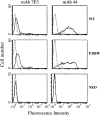Two functional states of the CD11b A-domain: correlations with key features of two Mn2+-complexed crystal structures
- PMID: 9852148
- PMCID: PMC2132978
- DOI: 10.1083/jcb.143.6.1523
Two functional states of the CD11b A-domain: correlations with key features of two Mn2+-complexed crystal structures
Abstract
In the presence of bound Mn2+, the three- dimensional structure of the ligand-binding A-domain from the integrin CR3 (CD11b/CD18) is shown to exist in the "open" conformation previously described only for a crystalline Mg2+ complex. The open conformation is distinguished from the "closed" form by the solvent exposure of F302, a direct T209-Mn2+ bond, and the presence of a glutamate side chain in the MIDAS site. Approximately 10% of wild-type CD11b A-domain is present in an "active" state (binds to activation-dependent ligands, e.g., iC3b and the mAb 7E3). In the isolated domain and in the holoreceptor, the percentage of the active form can be quantitatively increased or abolished in F302W and T209A mutants, respectively. The iC3b-binding site is located on the MIDAS face and includes conformationally sensitive residues that undergo significant shifts in the open versus closed structures. We suggest that stabilization of the open structure is independent of the nature of the metal ligand and that the open conformation may represent the physiologically active form.
Figures








Similar articles
-
Solvent-accessible residues on the metal ion-dependent adhesion site face of integrin CR3 mediate its binding to the neutrophil inhibitory factor.J Biol Chem. 1996 Jul 5;271(27):15858-61. doi: 10.1074/jbc.271.27.15858. J Biol Chem. 1996. PMID: 8663417
-
Cation binding to the integrin CD11b I domain and activation model assessment.Structure. 1998 Jul 15;6(7):923-35. doi: 10.1016/s0969-2126(98)00093-8. Structure. 1998. PMID: 9687375
-
Conformational changes in tertiary structure near the ligand binding site of an integrin I domain.Proc Natl Acad Sci U S A. 1999 Mar 2;96(5):2215-20. doi: 10.1073/pnas.96.5.2215. Proc Natl Acad Sci U S A. 1999. PMID: 10051621 Free PMC article.
-
NMR and mutagenesis evidence for an I domain allosteric site that regulates lymphocyte function-associated antigen 1 ligand binding.Proc Natl Acad Sci U S A. 2000 May 9;97(10):5231-6. doi: 10.1073/pnas.97.10.5231. Proc Natl Acad Sci U S A. 2000. PMID: 10805782 Free PMC article.
-
Integrin-ligand binding. Do integrins use a 'MIDAS touch' to grasp an Asp?Curr Biol. 1995 Jun 1;5(6):615-7. doi: 10.1016/s0960-9822(95)00124-2. Curr Biol. 1995. PMID: 7552170 Review.
Cited by
-
CD11b agonists offer a novel approach for treating lupus nephritis.Transl Res. 2022 Jul;245:41-54. doi: 10.1016/j.trsl.2022.03.001. Epub 2022 Mar 12. Transl Res. 2022. PMID: 35288363 Free PMC article. Review.
-
Exposure of acidic residues as a danger signal for recognition of fibrinogen and other macromolecules by integrin alphaXbeta2.Proc Natl Acad Sci U S A. 2005 Feb 1;102(5):1614-9. doi: 10.1073/pnas.0409057102. Epub 2005 Jan 21. Proc Natl Acad Sci U S A. 2005. PMID: 15665082 Free PMC article.
-
Structural basis of the leukocyte integrin Mac-1 I-domain interactions with the platelet glycoprotein Ib.Blood Adv. 2019 May 14;3(9):1450-1459. doi: 10.1182/bloodadvances.2018027011. Blood Adv. 2019. PMID: 31053572 Free PMC article.
-
Identification of novel agonists of the integrin CD11b/CD18.Bioorg Med Chem Lett. 2009 Dec 15;19(24):6902-6. doi: 10.1016/j.bmcl.2009.10.077. Epub 2009 Oct 22. Bioorg Med Chem Lett. 2009. PMID: 19879752 Free PMC article.
-
Differential effects of serum heat treatment on chemotaxis and phagocytosis by human neutrophils.PLoS One. 2013;8(1):e54735. doi: 10.1371/journal.pone.0054735. Epub 2013 Jan 22. PLoS One. 2013. PMID: 23349959 Free PMC article.
References
-
- Altieri DC. Occupancy of CD11b/CD18 (Mac-1) divalent ion binding site(s) induces leukocyte adhesion. J Immunol. 1991;147:1891–1896. - PubMed
-
- Altieri DC, Edgington TS. The saturable high affinity association of factor X to ADP-stimulated monocytes defines a novel function of the MAC-1 receptor. J Biol Chem. 1988;263:7007–7015. - PubMed
-
- Andrew DP, Berlin C, Honda S, Yoshino T, Hamann A, Holzmann B, Kilshaw PJ, Butcher EC. Distinct but overlapping epitopes are involved in alpha 4 beta 7-mediated adhesion to vascular cell adhesion molecule-1, mucosal addressin-1, fibronectin, and lymphocyte aggregation. J Immunol. 1994;153:3847–3861. - PubMed
-
- Bajt ML, Loftus JC. Mutation of a ligand binding domain of β3 integrin: integral role of oxygenated residues in αIIbβ3 (GPIIb-IIIa) receptor function. J Biol Chem. 1994;269:20913–20919. - PubMed
Publication types
MeSH terms
Substances
LinkOut - more resources
Full Text Sources
Other Literature Sources
Research Materials

